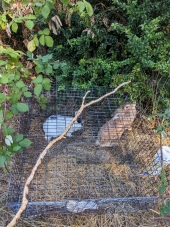


The Humble Soapnut - A Guide to the Laundry Detergent that Grows on Trees ebook by Kathryn Ossing
will be released to subscribers in:
soon!



 3
3




 3
3






 2
2




Skandi Rogers wrote:Seeds don't want or need a rich soil, most will germinate quite happily on a papertowel or in wet sand.
If they are not germinating at all then the soil is unlikely to have anything to do with it, it's more likely to be the water/heat/light that is an issue. It could also be that the seeds you have gotten are either old, or got cooked somewhere in the postal system.
 1
1








Priscilla Stilwell wrote:Is there a significant difference in starting seeds depending on the variety? I've been trying to soak the ones (especially) that have hard shells, but someone told me that's not necessary in the tropics. But my "tropics" is very dry compared to other tropics.
New location. Zone 6b, acid soil, 30+ inches of water per year.
https://growingmodernlandraces.thinkific.com/?ref=b1de16
Growingmodernlandraces.com affiliate




Burl Smith wrote:A packet of cucumber seeds yielded a germination rate of 4%. 4%! And the watermelon I threw in the compost quickly outdid them. I was disgusted. This year I'm saving cucumber seeds.
 1
1




Lauren Ritz wrote:
Priscilla Stilwell wrote:Is there a significant difference in starting seeds depending on the variety? I've been trying to soak the ones (especially) that have hard shells, but someone told me that's not necessary in the tropics. But my "tropics" is very dry compared to other tropics.
Yes, there are major differences. If the seeds are hard you may need to nick the shells. You may need to pour boiling water over them, or have them sit in water for a week. You may need to let them dry out or cold stratify and some need to be planted fresh. Some will germinate almost immediately and some will take months. Some need an acid bath. Lots of different ways of treating seeds.
My plant propagation book says lily seeds are slow to germinate. It says they should be sown fresh and have a much lower germination rate otherwise. Some lilies will germinate but then immediately go dormant until the next growing season (which you won't know until it comes back up after one to two years). The book doesn't give specific treatments for the seeds of either lilies or irises except to sow the seeds fresh. What others are you working with? I'll look them up.
 2
2




New location. Zone 6b, acid soil, 30+ inches of water per year.
https://growingmodernlandraces.thinkific.com/?ref=b1de16
Growingmodernlandraces.com affiliate
 1
1




Lauren Ritz wrote:"Plant Propagation" from The American Horticultural Society. Editor Alan Toogood, if that means anything. And no, you can't borrow it. :)
 1
1




'Every time I learn something new, it pushes some old stuff out of my brain.'




F Agricola wrote:Hello Priscilla,
Getting back to the basics may help - there's only five things to remember:
Seed, soil, moisture, temperature and light.
Seed:
I suggest you try obtaining packet seeds from a number of sources just to ensure viability - from a climate similar to Haiti would make sense. Although there may be limited variety, obtaining them from people on the island would be better still - acclimatised and proven strains.
Observe what other people grow - perhaps some of your choices are not well suited to the area without special care.
With small seeds you could make seed tape - using toilet paper and a glue made from flour and water (like papier-mâché)
Soil:
make seedling mix yourself. Sieved compost, washed course sand, coconut fibre, a small amount of native soil. Even dried and ground egg shells = calcium. Beware of local soil borne pathogens.
Manure and urine shouldn't be used in seedling/potting mixes - too concentrated. Save them for the garden. Ditto with wood shavings because of nitrogen depletion. Coarse bark for orchids and bulbs being the exception.
A weak compost/fish/seaweed tea can be applied weekly once the seedlings are hardened-up.
Moisture:
constant but only enough to allow seedling mix to stick to a finger when inserted. Soaking does aid germination in most instances, but is not absolutely necessary.
A hand spray that mists water is probably a gentler way to keep trays damp.
Temperature:
keep warm somewhere between 20C - 25C.
Light:
sunny position inside a house or shed, no wind. Preferably dabbled light, not direct tropical sunlight.
Ventilation could also be added. In that moist warm climate, mould and fungi will thrive. Suggest not using plastic bags/covers.
 2
2




 4
4




 2
2




New location. Zone 6b, acid soil, 30+ inches of water per year.
https://growingmodernlandraces.thinkific.com/?ref=b1de16
Growingmodernlandraces.com affiliate
 1
1








Alder Burns wrote:If you find that many seeds are rotting, or seedlings are "damping off" (rotting right at the soil line and falling over), or you're seeing mold forming; you might try sterilizing/pasteurizing your seedling potting soil. A solar cooker (which you should have for other purposes, given your climate!) is ideal for this, in a covered container. Have the soil moist so the moisture turns to steam. A quick way is to pour boiling water over a pot full of it till it drains hot out the bottom, but you may leach nutrients this way and leave the mix too soggy. Small insects and other troublesome creatures in the soil itself are also reduced this way.
 2
2




Work smarter, not harder.

|
Well don't expect me to do the dishes! This ad has been cleaned for your convenience:
Learn Permaculture through a little hard work
https://wheaton-labs.com/bootcamp
|

